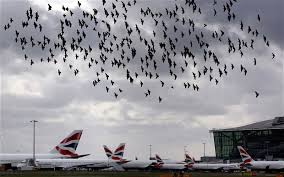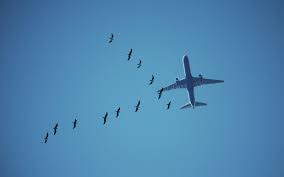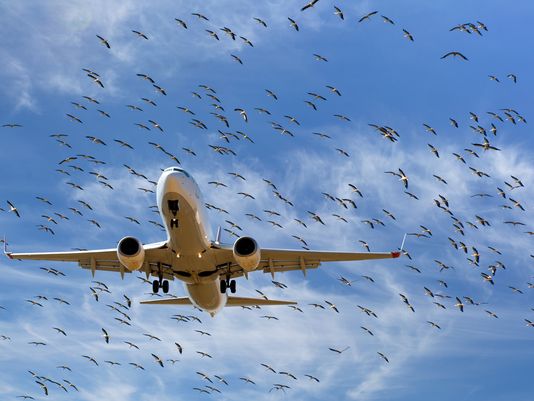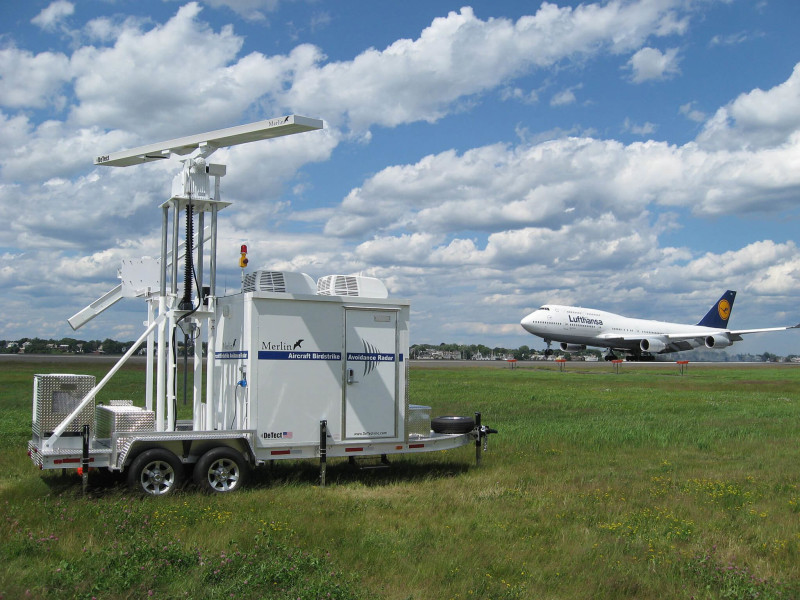June 2016 – Collision of Birds and Aviation – Part 1
Collision of Birds and Aviation – Part 1
 Bird strikes are a lesser hazard to aviation than other well-known hazards such as loss of control in flight, controlled flight into terrain, and runway excursions, but they can and do present risk that needs to be addressed. The first bird strike was recorded by the Wright brothers in 1905, and the aviation wildlife hazard has been a risk to aviation ever since. The ditching of US Airways flight 1549 on the Hudson River in 2009, was the dramatic result of dual engine thrust loss arising from an airborne encounter with a flock of geese. Although modern jet airliners meet and exceed the government regulations for bird strikes, accidents and serious incidents can occur. Aviation wildlife hazards encompass birds on the ground and in flight, terrestrial animals (such as rabbits), and even airborne animals such as bats; however, this article focuses on bird strikes in particular. Operators and flight crews should be aware of the risk of bird strikes, prevention strategies, and actions to take following a bird strike.
Bird strikes are a lesser hazard to aviation than other well-known hazards such as loss of control in flight, controlled flight into terrain, and runway excursions, but they can and do present risk that needs to be addressed. The first bird strike was recorded by the Wright brothers in 1905, and the aviation wildlife hazard has been a risk to aviation ever since. The ditching of US Airways flight 1549 on the Hudson River in 2009, was the dramatic result of dual engine thrust loss arising from an airborne encounter with a flock of geese. Although modern jet airliners meet and exceed the government regulations for bird strikes, accidents and serious incidents can occur. Aviation wildlife hazards encompass birds on the ground and in flight, terrestrial animals (such as rabbits), and even airborne animals such as bats; however, this article focuses on bird strikes in particular. Operators and flight crews should be aware of the risk of bird strikes, prevention strategies, and actions to take following a bird strike.
International and national legal sources for identification of liability for damage caused by collision of birds and aircraft
The Warsaw system or the Montreal Convention are an exclusive legal basis for indemnity in case of death and injury of passengers, or destruction, damage and loss of baggage and cargo.
For damages caused by strikes of birds and wildlife with aircraft, neither on level of ICAO, not on the level of the European Union, there has not been established any applicable instrument of the international private and public aviation law. For that reason, in case of claims for damages caused by strikes of birds and aircraft, there will be applied a basic obligation rule of a relevant court or a state referred to by conflict-of-law rules of the internationally recognized court. ICAO and EU have indirectly regulated liability for damage caused by strike of birds and wildlife with aircraft at airport, by defining measures and procedures to be taken by the parties involved in air traffic in order to reduce or eliminate a possibility of such a strike at airport and its vicinity.
But there are indeed some rules who regulate this: the international legal sources that establish measures and procedures for reduction and elimination of collision of birds and wildlife with aircraft at airport and its vicinity are as follows:
- Annex 14 to the Convention on the international civil aviation (Chicago Convention),
- ICAO Doc 9137 Airport Manual Service, Part 3. Wildlife Control and Reduction,
- ICAO Doc 9332 Manual on the ICAO Bird Strike Information,
- ICAO Doc 9184 Airport Planning Manual, Part 2. Land Use and Environmental Control.
Local legal sources have, by rule, taken over ICAO standards and recommendations, which define obligations, measures and actions to be taken by each involved party in order to reduce or eliminate a possibility of bird or wildlife strikes at airport and its vicinity.
Safety of air traffic is getting more and more in focus of ICAO, what is obvious from appendices to the Chicago Convention containing all the standards and recommendations adopted by ICAO.
 The airport operator has to keep documentary evidence of implementation of these measures and procedures which are to be used for prevention of wildlife habitats at airport area, as well as to inform the Directorate for Civil Aviation on each incident, accident or event caused by collision of the wildlife with aircraft in airport area. Airport operator is obliged to take actions either to eliminate or prevent placing a waste dump or any other sources that could attract wildlife at the airport or its vicinity, except in case a relevant study on assessment of the wildlife threat ascertains that it is unlikely that the wildlife could endanger safety of air traffic. If such resources cannot be eliminated, relevant authority of the local or regional self-government must provide for preparation of the study on risk assessment of such resources for aircraft and take care to reduce them to the minimum.
The airport operator has to keep documentary evidence of implementation of these measures and procedures which are to be used for prevention of wildlife habitats at airport area, as well as to inform the Directorate for Civil Aviation on each incident, accident or event caused by collision of the wildlife with aircraft in airport area. Airport operator is obliged to take actions either to eliminate or prevent placing a waste dump or any other sources that could attract wildlife at the airport or its vicinity, except in case a relevant study on assessment of the wildlife threat ascertains that it is unlikely that the wildlife could endanger safety of air traffic. If such resources cannot be eliminated, relevant authority of the local or regional self-government must provide for preparation of the study on risk assessment of such resources for aircraft and take care to reduce them to the minimum.
ICAO decided as well to define such measures through the ICAO Airport Services Manual, Part 3. Wildlife Control and Reduction, which recommends airport operators to prepare their own Bird/Wildlife Programme Control.
However an airport operator is obliged to develop, implement and provide evidence on having the Bird/Wildlife Programme Control, whose content should be adjusted to the size and complexity of the airport, taking in the account identification and risk assessment of bird and wildlife strikes with aircraft.
An airport operator is obliged to install a fence or similar barrier to prevent game and other animals, big enough to endanger aircraft, from going onto maneuvering surfaces. Compliance with the international standards in respect of the fence height, keeping the access gates and official passages locked and patrolled, preventing food sources, implementing passive environmental devices on the wildlife, altogether make a basis for elimination or reducing the liability for damage caused by collision of the wildlife and aircraft.
Technical aspects of bird strikes prevention
Birds and wildlife at airports are controlled by passive and active methods. Implementation of passive environmental are the most efficient way to prevent presence of birds and wildlife at airports. Environmental methods change the surrounding at the airport in order to make it unattractive for birds and wildlife. Proper implementation of the environmental methods is a prerequisite for elimination of birds and wildlife at airport. In absence of properly applied passive methods, implementation of active methods cannot have an optimal result.
- Airport operator employees’ duties, i.e.
- Manager who is responsible for preparation and implementation of the Program for prevention of bird strikes;
- Coordinator who monitors daily activities and analyzes collected information to make a risk assessment and then the Program for prevention of bird strikes,
- The staff engaged on bird strikes control should pass an ornithological training, too, in order to be able to recognize bird type depending on the way it flies, as well as to know how to remove dead birds after strike with aircraft.
- Process of reporting, collecting and recording of live and struck birds and wildlife animals.
- Process of analyzing the data and risk assessment regarding bird and wildlife threat in order to implement active and passive measures, what also includes a methodology of risk assessment.
- Management of habitats and land at airport and its vicinity, aimed at decrease of attractiveness of the area accommodating birds and wildlife. Where applicable, relevant measures should include techniques of managing the grass areas.
- Process of scattering or eliminating the wildlife and birds also includes use of lethal agents, if necessary.
- Process of building connections with other organizations and land owners so that airport operator becomes aware of additional risks for appearance of birds in infrastructural buildings, vegetation, land and activities near the airport (sowing, harvest, hunting, characteristics of water and ground surfaces, etc.).
ICAO’s recommendation to airport operator is to make connections with the local community and actively participate in development of physical plans and thus reduce a possibility of potential risks (rubbish dumps, crops, etc.).
Carrier’s liability to passengers for damage caused by bird strikes
 Bird strikes can cause material damage (damage on aircraft or on the ground due to a crash, including damage to houses and infrastructure) and consequential damage (death or injuries of passengers and people on the ground, fear sustained by passengers, aircraft crew and persons on the ground in case of an air crash). Due to a bird strike aircraft can be damaged or destroyed in a whole or partially, causing direct, indirect or consequential damage. Direct damage is a consequence of a damage event, i.e. when legal property is directly affected, like destroyed or damaged aircraft, while the indirect damage is a further consequence of the event caused to other legal properties. Indirect damage is an indirect consequence of damage event, which in spite of being caused by the original damage event, actually occurred after another event, but under favorable circumstances created by the original event. Indirect damage would be, for example, a loss of carrier’s profit, compensation to passengers for sustained damage, etc.
Bird strikes can cause material damage (damage on aircraft or on the ground due to a crash, including damage to houses and infrastructure) and consequential damage (death or injuries of passengers and people on the ground, fear sustained by passengers, aircraft crew and persons on the ground in case of an air crash). Due to a bird strike aircraft can be damaged or destroyed in a whole or partially, causing direct, indirect or consequential damage. Direct damage is a consequence of a damage event, i.e. when legal property is directly affected, like destroyed or damaged aircraft, while the indirect damage is a further consequence of the event caused to other legal properties. Indirect damage is an indirect consequence of damage event, which in spite of being caused by the original damage event, actually occurred after another event, but under favorable circumstances created by the original event. Indirect damage would be, for example, a loss of carrier’s profit, compensation to passengers for sustained damage, etc.
Damage caused by a bird strike belongs to concrete damages because it is substantiated by material evidence, like inspection of aircraft, expert evaluation, witnesses and identification papers, while for an abstract damage the existence of damage is presumed and its value is established as a lump sum or according to the pre-set criteria.
In case of death or injuries of the international air traffic passengers that resulted from a bird strike out of airport area in any flight stage, passengers or their families will bring legal action against the carrier requiring compensation in accordance with the Warsaw system or the Montreal Convention.
 According to the Montreal Convention provisions, carrier’s liability for the damage suffered by passengers in the international air transport is in first degree strict liability, while in second degree it is subjective. If applicable instrument of the internationally competent court is the Warsaw system provisions, it will be a subjective liability of the carrier for the damage suffered by passengers in the international air transport. However, in case of a collision of birds or the wildlife at the airport in accordance with ICAO recommendations, it is also possible that passengers or their relatives may lodge a cumulative claim for a damage compensation against the carrier, airport operator or the Air Traffic Control Centre. Since a venue of damage event in the international air law is unpredictable and most often unconnected with the country where it occurred, neither the Warsaw nor the Montreal Convention do not stipulate a jurisdiction of a court in the country where a damage event happened (forum delicti).
According to the Montreal Convention provisions, carrier’s liability for the damage suffered by passengers in the international air transport is in first degree strict liability, while in second degree it is subjective. If applicable instrument of the internationally competent court is the Warsaw system provisions, it will be a subjective liability of the carrier for the damage suffered by passengers in the international air transport. However, in case of a collision of birds or the wildlife at the airport in accordance with ICAO recommendations, it is also possible that passengers or their relatives may lodge a cumulative claim for a damage compensation against the carrier, airport operator or the Air Traffic Control Centre. Since a venue of damage event in the international air law is unpredictable and most often unconnected with the country where it occurred, neither the Warsaw nor the Montreal Convention do not stipulate a jurisdiction of a court in the country where a damage event happened (forum delicti).
In respect of the Warsaw and Montreal Convention, jurisdiction is international instead of local. The international jurisdiction of court in countries signatories to the Warsaw system in the international air transport of passengers, baggage and cargo is stipulated by Article 28. of the Warsaw Convention. It says that there are four international court jurisdictions and that plaintiff may bring suit against the carrier as follows:
- before the court of the domicile of the carrier;
- its principal place of business;
- where it has a place of business through which the contract has been made, and
- before the court at the place of destination.
The Montreal Convention, after adopting these four international jurisdictions regulated by the Warsaw Convention, introduced the fifth international jurisdiction according to which a passenger may bring suit against the carrier if the passenger has his permanent residence, from/to which the carrier has its flights either by its own aircraft or other airline’s aircraft, in accordance with commercial agreement, and in which that airline carries out transport of passengers, in premises which the carrier lets out on lease or own, or which are let out or owned by other airline with whom the mentioned carrier has signed a commercial agreement.
Carrier’s liability for damage on the ground caused by a crash after a bird strike
 Persons on the ground who suffered damage due to an aircraft crash will claim damage in accordance with provisions of the Convention on damage caused by a foreign aircraft on the ground (i.e. Rome Convention), being modified by Protocol on modification of the Convention on damage caused by a foreign aircraft on the ground (i.e. Montreal Protocol 1978), or in accordance with provisions of the substantive law of the international jurisdiction court whose implementation is indicated by conflict-of-law norms of the court. Implementation of the Rome Convention is limited, under condition that aircraft has crashed down and caused damage in the country that is a contracting party to the Rome Convention, and that it was registered in the country that ratified the Rome Convention, and in case of implementation of the Montreal protocol 1978, regardless of the aircraft registration country, if the operator has its main office or runs its business in the country that is a contracting party to the Montreal protocol from 1978. The Rome Convention is not implemented on damages caused by military, customs or police aircraft. According to the Rome Convention or the Montreal protocol from 1978, the right for compensation is granted to any person that suffered damage on the ground if he/she proves that damage was caused by a flying aircraft or from persons or the objects falling down from the aircraft.
Persons on the ground who suffered damage due to an aircraft crash will claim damage in accordance with provisions of the Convention on damage caused by a foreign aircraft on the ground (i.e. Rome Convention), being modified by Protocol on modification of the Convention on damage caused by a foreign aircraft on the ground (i.e. Montreal Protocol 1978), or in accordance with provisions of the substantive law of the international jurisdiction court whose implementation is indicated by conflict-of-law norms of the court. Implementation of the Rome Convention is limited, under condition that aircraft has crashed down and caused damage in the country that is a contracting party to the Rome Convention, and that it was registered in the country that ratified the Rome Convention, and in case of implementation of the Montreal protocol 1978, regardless of the aircraft registration country, if the operator has its main office or runs its business in the country that is a contracting party to the Montreal protocol from 1978. The Rome Convention is not implemented on damages caused by military, customs or police aircraft. According to the Rome Convention or the Montreal protocol from 1978, the right for compensation is granted to any person that suffered damage on the ground if he/she proves that damage was caused by a flying aircraft or from persons or the objects falling down from the aircraft.
Liability for death or injuries cannot exceed the amount of 125.000 SDR per person.
If the liability limits defined by the Rome Convention or the Montreal Protocol 1978 are analyzed, it is obvious that the biggest limit from the Rome Convention equals approximately 26.000 EUR per person, and by the Montreal Protocol from 1978 it equals approx. 148.000 EUR per person. Carrier’s liability for damage on the ground is unlimited in case the carrier caused it deliberately or by negligence of airline’s representative, which is done with purpose to cause the damage.
Strict liability of aircraft operator for damage on the ground is established.
Carrier may be released from liability for damage on the ground if proves that the damage resulted from omission of the person who sustained the damage or his/her representative, or if the damage is a consequence of armed conflicts, riots, or if the aircraft that caused the damage was seized by the government authorities. In case of hijack or other misuse of aircraft, there will be a joint and several liability of the carrier and the person who used aircraft illicitly. The carrier may be exempted from liability for damaged on the ground caused by unauthorized use of aircraft if he proves that he had paid due attention to prevent such misuse.
For further information and comment, please contact Arthur Flieger (flieger@fliegerlaw.com, +32 3 238 77 66)
© 2016 A. Flieger – This publication is defined to provide accurate and authoritative information in regard to the subject matter covered. It is transmitted with the understanding that the publisher is not engaged in rendering legal, or any other professional services. If legal advice or other expert assistance is required, professional services should be sought. You can always contact A. Flieger at flieger@fliegerlaw.com.






